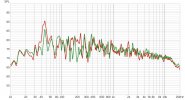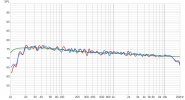Right now, I have a (mostly) all-analog system.
Only exception is the Oppo BDP-105 and Bryston BDA-3 for digital files and media. No streaming. I am very pleased with the sound.
My listening is divided about half and half between LPs and CD/SACD/Digital files with a bit of FM radio thrown in.
I have used REW to assist me in placing the speakers, the sub and sound traps (Real Traps products). For the final tweaks I gently used a graphic equalizer (dBx 1231).
I've managed to tame all but one room mode.
Frequency response is"flat" to about 2KHz where I let the FR drop faster than the suggested curve since I have aversion to high frequency sizzle.
Phase response is not minimum phase. There's many more 360 phase shifts than are predicted for a minimum phase system. She attached graph.
View attachment 374675
OK. Great. But now I'm wondering if the sound would be even more enjoyable than now using a DSP for room correction (keeping the traps) and for crossover. This would eliminate my trusty, great sounding ML#38s pre, dBx EQ, Sublime Acoustic K231 crossover (75Hz) and Bryston BDA-3. In place I would have the MiniDSP Flex Balanced or SHD. II guess I could just buy one and get the answer. But I'd like to hear about other journeys such as mine before I spend the money.
And is all that excess phase shift wreaking damage to my sound?
I am quite emotionally attached to all my components and need a significant amount of persuasion before I replace any component. I have tried a few other pre and power amps, but have always come running back because the sound didn't get better, got worse, or brought other unwelcome problems.
Don't be shy about being overly technical. I have an MS in Physics (Optics/Electronics) and have spent my entire career doing product development.
Thanks for your attention!
Rest of System:
1. Technics SL-1200G TT
2. Parasound phono pre
3. Bryston 2.5B^3 power amp
4. Revel f208 Floorstanding speakers
5. Hsu ULS-15 Sub.

